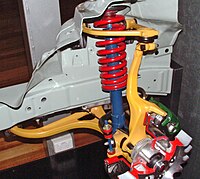
Photo from wikipedia
Abstract Recently, Intervention-Autonomous Underwater Vehicles (I-AUVs), started to grab researchers attention. While prior systems rely on variations of the task-priority redundancy control framework, our recent research demonstrated experimental results using… Click to show full abstract
Abstract Recently, Intervention-Autonomous Underwater Vehicles (I-AUVs), started to grab researchers attention. While prior systems rely on variations of the task-priority redundancy control framework, our recent research demonstrated experimental results using search-based motion planning for a single arm floating-based intervention in known and unknown environments. In this work, we present a search-based motion planning algorithm applied to the coordinated manipulation problem of a dual-arm Intervention AUV, in an object transportation mission (e.g. pipe transportation). Two Challenges are considered: the high-dimensionality of the system, and the motion coordination between the mobile base and both working arms. The latter challenge is a major one if accurate execution is required, especially considering the floating nature of the AUV. Our approach relies on exploiting the loose coupling between the different system components. We show for the first time the use of a search-based planner on a dual-arm underwater manipulator. In addition, we support our claims with a simulated demonstration, successfully performing a coordinated dual-arm underwater intervention.
Journal Title: IFAC-PapersOnLine
Year Published: 2019
Link to full text (if available)
Share on Social Media: Sign Up to like & get
recommendations!